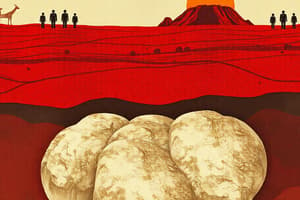Podcast
Questions and Answers
What is the main reason behind the red color of red soil?
What is the main reason behind the red color of red soil?
- Intense leaching owing to heavy tropical rains
- High temperature and heavy rainfall
- Presence of iron in the crystalline, igneous & metamorphic rock (correct)
- Lack of nitrogen and potassium
Which type of soil is acidic, coarse, and crumbly in texture?
Which type of soil is acidic, coarse, and crumbly in texture?
- Alluvial soil
- Laterite soil (correct)
- Yellow soil
- Black soil
Which region is NOT known for the presence of laterite soil?
Which region is NOT known for the presence of laterite soil?
- Jharkhand (correct)
- Karnataka
- Tamil Nadu
- Madhya Pradesh
What is a major deficiency in laterite soil that affects its fertility?
What is a major deficiency in laterite soil that affects its fertility?
Which type of soil is formed from igneous rock?
Which type of soil is formed from igneous rock?
In which type of soil are crops cultivated with the use of fertilizers and irrigation?
In which type of soil are crops cultivated with the use of fertilizers and irrigation?
What are the climatic variables of greatest significance in soil formation?
What are the climatic variables of greatest significance in soil formation?
What function does the decayed leaf material from vegetation add to the soil?
What function does the decayed leaf material from vegetation add to the soil?
Which type of soil is rich in potash and phosphoric acid but deficient in nitrogen and humus?
Which type of soil is rich in potash and phosphoric acid but deficient in nitrogen and humus?
What is a key characteristic of arid soils?
What is a key characteristic of arid soils?
What is the main factor responsible for the formation of laterite soil?
What is the main factor responsible for the formation of laterite soil?
Which of the following nutrients are typically lacking in laterite soils, making them unsuitable for cultivation?
Which of the following nutrients are typically lacking in laterite soils, making them unsuitable for cultivation?
How are Indian soils classified based on color, thickness, texture, and physical properties?
How are Indian soils classified based on color, thickness, texture, and physical properties?
How would you describe the texture of laterite soils?
How would you describe the texture of laterite soils?
From what type of sediment are most Indian soils derived, especially in the Indo-Gangetic plain?
From what type of sediment are most Indian soils derived, especially in the Indo-Gangetic plain?
What is a significant feature of the kankar layer formations in arid soils?
What is a significant feature of the kankar layer formations in arid soils?
Why are dry crops like barley, cotton, and wheat suitable for cultivation in arid soils with irrigation and fertilizers?
Why are dry crops like barley, cotton, and wheat suitable for cultivation in arid soils with irrigation and fertilizers?
What type of erosion occurs when the top layer of soil is removed over a large area by running water?
What type of erosion occurs when the top layer of soil is removed over a large area by running water?
Flashcards are hidden until you start studying
Study Notes
Red Soil and Yellow Soil
- Formed from igneous rock, with a red color due to the presence of iron in the crystalline, igneous, and metamorphic rock.
- Found in deep depressions, with loamy soil, and in uplands, with loose gravels and highly coarse material.
- Deficient in phosphoric acid, organic matter, and nitrogenous material, but fairly rich in potash.
- Crops such as cotton, wheat, rice, pulses, and millets can be produced with the use of fertilizers and irrigation.
- Found in regions such as Tamil Nadu, parts of Karnataka, southeast of Maharashtra, Madhya Pradesh, Orissa, and the Chota Nagpur Plateau of Jharkhand.
Laterite Soil
- Develops in areas with high temperature and heavy rainfall, resulting from intense leaching.
- Acidic in nature, with a coarse and crumbly texture.
- Lacks fertility due to the lack of nitrogen, potassium, and organic elements.
- Not suitable for cultivation, but with irrigation and fertilizers, crops such as tea, coffee, rubber, cinchona, coconut, cashewnut, and tapioca can be grown.
- Found in regions such as Karnataka, Kerala, Tamil Nadu, Madhya Pradesh, and the hilly areas of Orissa.
- The kankar layer formations in the bottom horizons restrict the infiltration of water.
Soil Erosion
- The removal of soil by natural forces like wind and water, more rapidly than the soil-forming process can replace it.
- Types of soil erosion include:
- Water erosion: caused by running water, with types such as sheet erosion.
- Other factors that affect soil erosion include relief, climate, and natural vegetation.
Classification of Soil
- Soil can be classified based on color, thickness, texture, and physical properties.
- Indian soil is classified into:
- Alluvial soil
- Black soil
- Red and yellow soil
- Laterite soil
- Arid soil
- Forest soil
Alluvial Soil
- Formed from sediments deposited by rivers, as in the Indo-Gangetic plain.
- Consists of sand, silt, and clay.
- Features of alluvial soil:
- Most widespread soil in India.
- Most fertile soil.
- Intensively cultivated and densely populated.
- Fine-grained, rich in potash and phosphoric acid, but deficient in nitrogen and humus.
- Classified into different types based on age.
Studying That Suits You
Use AI to generate personalized quizzes and flashcards to suit your learning preferences.




